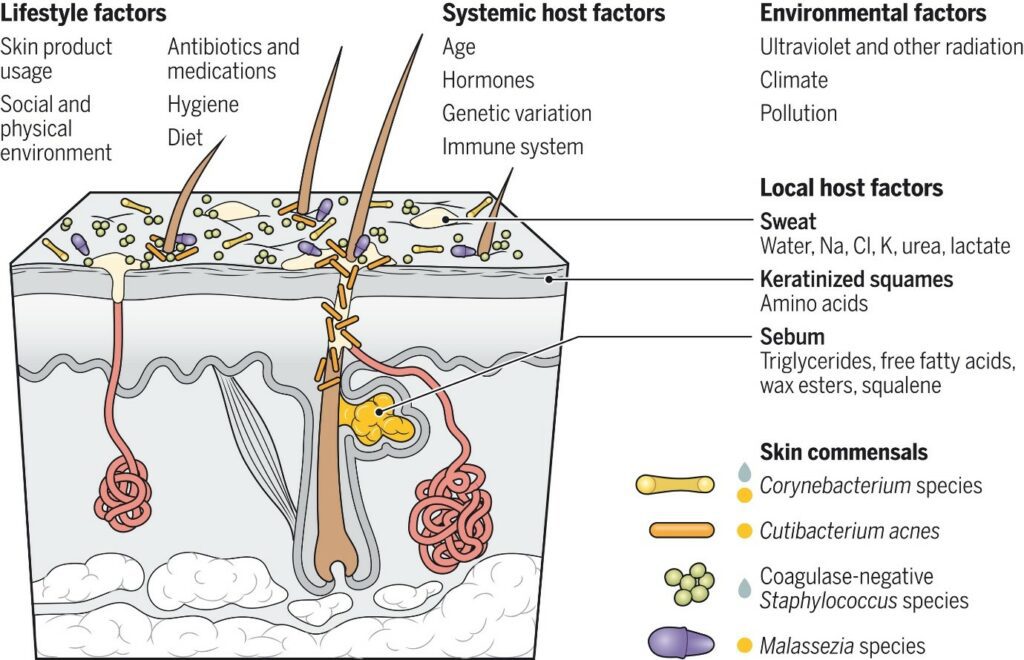The microbiome has become the fastest growing and shining star of 2022 skincare, with the cosmetics category expected to grow by 7.5% CAGR until 2026.
It is hard as consumers, formulators and educators in this space to navigate through the confusions of terms that are continually thrown around such as “pro-biotic skincare†or “Pre-biotic Health†or “microbiome friendly†ingredients, Coupled with the fact that there is no official regulation or definitions around these terms, it’s easy to see the confusion throughout the skin-science community. How can this growing claim in our personal care industry, be validated?
The microbiome is unique from person to person, but everyone needs a balance and correct level of strains to keep the skin barrier healthy. The prevalence of bacteria strains informs our skin type. Certain bacteria might be high in one skin type yet not create acne, but produce comedones and other issues in another skin type. It is important to understand that skin microbiome is different with different ethnicities, ages, life stages and climate conditions.
We must not assume that using the mildest products on our skin will benefit the micobiome of our skin or that using potent ingredients such as exfoliating acids or retinols aren’t out of the picture either. The microbiome is quite resilient. You can have an anti-aging routine with actives like glycolic acids or retinoids and still have microbiome-friendly products, not creating long-term damage. It’s the overall composition of the final formula that outweighs any one ingredient when it comes to assessing microbiome compatibility.
Speaking to Hedy from MyMicrobiome, she explains “the importance of validating your products to ensure that they respect the biome of your skin. This is the gold standard in testing a raw material or a finished product to be able to certify that it is microbiome-friendlyâ€.
MyMicrobiome is a young and committed team of mostly female scientists and microbiome enthusiasts. Their mission is to spread the knowledge about a healthy, unharmed microbiome and to serve as a decision-making tool for customers and profiling tool for brands.
MyMicrobiome was founded in 2018, the cornerstone for the certification institute. Only three years later in 2021, the increasing demand for microbiome research and expertise resulted in the spin-off MyMicrobiome GmbH in Germany, with its own laboratories. The MyMicrobiome GmbH offers individualized R&D services and consultation.
Testing the skins microbiome is on the rise as consumers want to know how to treat their deficiencies and their skin conditions.
Two such companies offers this technology to consumers and brands.
The first is Skin Trust Club which shows you that with a simple skin swab, you can see your exact skin type by analysing your unique skin microbiome.
It is as simple as ordering your self test kit, downloading the APP. As no two skin types are the same your microbiome is tested and a recommended skin regime is tailored for you.
The other is the Sequential Skin. Although the concept is the same you order your self testing kits to do at home, send your swabs back to Sequential and within 2-3 weeks you will have your results of your unique microbiome.
The benefits of test kits such as these brings innovative skin testing results tailored to you so that this analysis allows you to choose the right products and treatments to increase your skins overall wellbeing,
The science and study around the Microenvironment and the Microbiome of skin is such a complex one and it’s still ongoing. However, let’s take a brief look at the science behind the microbiota and the role it plays in the maintenance & health of the skin barrier function.
HEALTHY SKIN IS THE FOUNDATION OF A BALANCED SKIN MICROBIOME
We all know that our skin forms a protective barrier against the external environment and is our first line of defence against toxic, solar, and pathogenic stresses.
The skin is the primary source of nutrients to it’s microbiome. The primary determinant of microenvironment conditions such as pH, water availability, temperature and osmolality, the key determinant of physical stability through desquamation and the major source of naturally derived antimicrobial peptides and lipids.
The skin is composed of several layers, the living tissue of the dermis and epidermis and the outer facing layer of the terminally differentiated desquamating keratinocytes called the stratum corneum. Although the primary role of the stratum corneum is to prevent water loss from the body and protect the skin by creating a physical barrier, the structure is also a key pillar in how healthy skin manages its microbiome, discoursing pathogens and maintaining the presence of commensal organisms [1].
As keratinocytes move outwards, they undergo a process of terminal differentiation, expressing specialised keratins such as K1 and K10, and late differentiation markers such as involucrin, loricrin and filaggrin, followed by conversions of filaggrin into natural moisturising factors (NMFs). In the last stages of keratinocytes desquamation, there is a controlled shedding of dead skin cells and production of new cells which allows for the thickness of the stratum corneum to be maintained. The shedding process lends to the microenvironment and furthermore, the microbiome of the skin, as the process of shedding in turn means that the microorganisms are similarly shed.
Fundamentally, the desquamation process can potentially cause a low availability of free water on the surface of the skin. Studies have shown that skin hydration, as measured by a corneometer, can impact the proportions of cutibacteria and staphylococci on the face [2].
There are many factors that contribute to the microenvironment of the skin; in particular:
- The Acid Mantle: Good microbes on the skin are supported by a more acidic pH of the skin, around 5.0 [3]
- Antimicrobial Lipids (AMLs): Healthy Skin can produce a range of antimicrobial free fatty acids (FFA) and sphingosines which display natural antimicrobial activity. In atopic skin, these FFA and sphingosines are reduced [4] [5].
One of the major drivers of the skin’s microbial ecology is the pilosebaceous unit, which consists of the hair shaft, the hair follicle, the sebaceous gland, and the erector pili muscle. Sebaceous glands excrete a waxy, oily substance called sebum that emolliates the skin and selects for microbial species that metabolize the nutrients it contains. The pilosebaceous unit is also hypoxic, providing an ideal environment for the bacteria Cutibacterium acnes. Other signature bacteria of the skin surface include the coagulase-negative staphylococci (CoNS) species, such as Staphylococcus epidermidis, which are equipped to adhere and persist on human skin and tolerate the conditions. Skin sites with higher moisture and occlusion (e.g., the groin, axilla, and umbilicus) are enriched by Corynebacterium species that can be lipid-dependent and slow-growing in culture seen in Fig 1.

Fig. 1. Factors that influence the microbial colonization of skin.
If you are formulating using ingredients such as retinols or AHA or BHA into a product, ensure that there are plenty of emollients and occlusives in there as well to compensate. The idea of one ingredient being good or bad for your microbiome comes from the whole clean beauty trend. But it’s about looking at the bigger picture of what the ingredient is a part of in the formulation, it’s a lot more complex. A minimalist routine, not necessarily minimalist formulas, in order to best gauge product efficacy.
References
- Elias, P., Stratum Corneum Defensive Functions: An Integrated View. Journal of Investigative Dermatology., 125, 2, 180-250, 2005.
- Mukherjee, S., Mitra, R., Maitra, A., Gupta, S., Kumaran, S., Chakrabortty, A., Majumder, P., Sebum and Hydration Levels in Specific Regions of Human Face Significantly Predict the Nature and Diversity of Facial Skin Microbiome. Scientific Reports, 2016
- Lambers, H., Piessens, S., Bloem, A., Pronk, H., Finkel, P., Natural Skin Surface pH is on Average below 5, which is beneficial for its resident flora. International Journal od Cosmetic Science, 28, 359, 2006
- Takigawa, H., Nakagawa, H., Kuzukawa, M., Mori, H., Imokawa, G., Defienct Production of Hexadecenoic Acid in the Skin Is Associated in Part with the Vulnerability of Atopic Dermatitis Patients. Dermatology, 211, 3, 340, 2005
- Arikawa, J., Ishibashi, M., Kawashima, M., Takagi, Y., Ickikawa, Y., Imokawa, G., Decreased levels of Sphingosine, A Natural Antimicrobial Agent, may be Associated with the Vulnerability of the Statum Corneum from Patients with Atopic Dermatitis, Journal of Investigative Dermatology., 119, 2, 433-439, 2002

